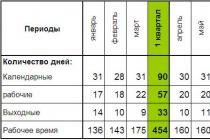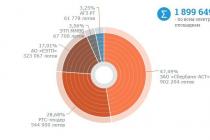When comparing central processors for smartphones from MediaTek and Qualcomm, we will consider the main parameters by which the buyer can make a choice in favor of one of the CPUs. Which one is better and why, on many forums, users prefer Qualcomm products, is this really the case on the market?
We can say that the two firms Qualcomm and MediaTek are the main suppliers of CPUs for smartphones today. Choosing a phone according to its characteristics, each buyer will be faced with the products of these companies in the form of a central processor. So the device on which processor to buy? Which company? Consider the main differences point by point.
Graphics
Better graphics from Qualcomm. MTK has the best processor for gaming today - Helio X10, it has a PowerVR G6200 video core. This is an average video processor today (if not worse). But the best solution with video for today from Helio X20 and X25 is the Mali T-880 core.
Yes, the Mali T-880 is a good video processor, even Samsung uses it in its flagship models. But each video processor differs in the number of cores, which is not surprising for today's chips. And in the Mali-T880, Samsung uses 12 cores (MP12) in its top processor, while MediaTek uses only 4 (MP4) in its Helio X25 and X20. A maximum of 16 cores can be used in the T880.
What gives more cores? And it gives more GFlops (FLoating-point Operations Per Second). Gigaflops is a non-systemic unit used to measure the performance of computers, showing how many floating point operations a given computing system performs per second. It is important for us that this value is used to measure the performance of a video card and by it we can to some extent compare video processors. There is also optimization, structure, executable instructions, etc. But for now, let's take GFLOPS into account.
- Mali-T880 MP12 - 265 GFLOPS,
- Mali-T880 MP4 - 115 GFLOPS.
But we compared this to each other different versions Mali-T880 from ARM Limited. As of December 2016, Mali's newest video processor is the G71.
But the video processor in the flagship Snapdragon 821 chips from Qualcomm is called the Adreno 530, and it produces 519 GFLOPS. For comparison:
- Snapdragon 650 with Adreno 510 - 180 GFLOPS,
- Snapdragon 430, 435 with Adreno 505 - 48.6 GFLOPS.
Conclusion: if we compare the top models of processors and then in pairs from the same price category, then Qualcomm has better graphics.

Graphics are not important for everyone in everyday work, the advantage in graphics performance will be noticeable in heavy games, in other cases you will have no complaints about MediaTek chips.
Communication modules (modems)
Communication 3G, 4G is carried out through modems in the phone, each modem works on a certain frequency(transmission speed). So also in different countries ah, only certain categories of communication can work. That is, the supported communication standards (simultaneously for different countries), maximum frequency work of reception and transmission and determines the best modem. And for today, Qualcomm has the best modems. But MediaTek has created modems over the past couple of years that can cover the needs of most consumers.
But Snapdragon has the best modems of any manufacturer. There is even a modem that supports all communication standards for any country, but its price is still very high. And already in December 2016, the Snapdragon X50 5G modem was presented for 5G networks, which are still being planned.

If you do not travel and do not visit exotic countries, then you will not have problems with modems of any company.
Optimizing programs
MTK has less optimization for programs. But this is more a software problem than a hardware problem. But Qualcomm is more popular, so the developers optimize programs for these processors more.
Third party firmware
There are fewer custom firmwares for MediaTek. Custom firmware is a kind of modified or modified firmware. In general, all firmwares that are not made by the manufacturer are custom ones. These firmwares have more improved functionality and can significantly improve performance.
Is this really such a minus? For someone else, for many consumers, this is probably not a problem at all. But who needs different firmware, it is better to pay attention to Qualcomm products.
Power consumption, operating frequencies
Two characteristics: power consumption and maximum operating frequency, are tied to such a parameter as the technical process. For us, ordinary consumers, this characteristic is not important. But there is still a difference in CPU heating (energy efficiency) with a different process technology. The technological process is measured in nanometers (nm) and today the newest technological process is 10 nm, and the outdated 28 nm. The smaller the technical process, the lower the operating currents, respectively, less power in watts and less heat generation. If the currents and operating voltage are lower, the operating frequencies can be increased.
In reality, it is impossible to notice the difference between the 14 nm and 20 nm process technology. Of course, experts will notice and measure everything, but for ordinary users it doesn't matter much. But you need to remember that if the processor will work at maximum load, for example, games, then the heat dissipation will be maximum. This is where a smaller process technology will play a role. With a smaller technological process, the chip will heat up less.
Today, Qualcomm's flagship processors have a 14nm process technology, while top-end chips from MediaTek are developed at 20nm. And it is only planned to make Helio X30 on a 10 nm process technology.

But if you take the processors Qualcomm Snapdragon 650, 652, 430, then they are made at 28 nm. Today, these are considered one of the best processors for the middle price category and in operation, they show themselves perfectly, do not overheat, have normal frequencies. So this once again confirms that ordinary buyers do not need to pay special attention to the parameter of the technological process.
And energy consumption also depends on optimization software to the hardware, screen characteristics, etc. So you can find examples of severe overheating in smartphones running on processors from both firms. You can argue here for a long time, which of them is more energy efficient.
Qualcomm processors are believed to be more efficient, run cooler, and perform better. But it must be borne in mind that other hardware and software modules... If you remember the Snapdragon 810, then everyone will immediately think about a very hot processor, it overheated the most. But Sony released its smartphone on this processor, and it did not get warm. It's just that Sony has made a normal heat sink. MTK did not have such problems. But you need to understand that the bulk of MediaTek processors are for medium budget and little budget smartphones... And manufacturers in this segment are not always engaged in software optimization or hardware improvement of the device. Therefore, the problems of the device are not always related to the CPU. This applies to both heating and lags in work.
As for overheating of the central processor, it is noticeable when performing heavy tasks such as games, complex programs. But if the smartphone performs its standard tasks, then you will not notice a serious overheating of the device, if there is any processor there.
Price
This is where MediaTek gets its advantage, which allows it to stay on the market and compete successfully with other companies. Phones on Qualcomm processors no longer stand out in price, as before, for example, a middle-class device could be bought for $ 150. But smartphones at a lower price are usually built on a processor from MediaTek.
conclusions
Other processor manufacturers such as Samsung, Apple, Huawei make them only for their devices. Therefore, in the mobile chip market, competition is between Qualcomm and MediaTek. Yes, processors from Qualcomm outperform MediaTek and their processors are used in flagship and mid-budget smartphones. And MediaTek over the years of development and competition has made its chips worthy of attention and corresponding to their price, their products have completely closed the budget segment and are used in some models of top smartphones. It can even be assumed that without MediaTek products there would be no smartphones under $ 100, but with acceptable characteristics.
Competition among processor manufacturers leads not only to direct attempts to make their product the best on the market, but also to the use of marketing gimmicks, successfully raising the reputation of a certain brand and at the same time discrediting others.The prevailing stereotypes do not always correspond to the truth, which is why it is especially important to dispel some myths about mobile processors.
To a question " Which mobile processor is the best?”Must be approached in detail.
Of course, we do not choose a smartphone solely because of the processor, other filling is no less important. However, without the competent packaging of the chipset and other components, even the top-end and most productive mobile processor can literally turn out to be useless.
We hope that our excursion into the world of processors and their manufacturers will be useful for you.
Terminology
Usually, the concepts "processor" and "chipset" are taken as synonyms, but this is not completely true. Modern mobile processors are part of SoC(System on Chip), on which other elements are located.
Outwardly, the chipset is similar to the old-style processors, but in essence the chipset is a platform for placing components, some of which are responsible for graphics, sound, orientation in space, etc, and the processor itself is just one of the components.
For example, schematically a chipset Snapdragon 820 looks like this:
Which processor is the best?
The answer to this question will logically differ for different categories of users.
Some users want to squeeze the maximum out of the smartphone, using the device not only as a dialer, but also as a game center. Sly marketers have found a loophole on how to attract the attention of just such an active type of users and at the same time save money - equip a smartphone with a 4-, 8-core processor, but with minimal clock frequency.
In this case, not an expert in the field mobile phones sees a tasty line in the specifications for an 8-core processor and considers the device to be very productive by default. But actually a 4-core processor with high core clock speeds easily outperform some lower clock 8-core processors.
But knowledge in the field of processor frequency does not guarantee correct selection gadget.
Hidden characteristics
There are hidden characteristics about which information is sometimes very difficult to find.
Important is technological process, by which the processor is executed. Roughly speaking, the process technology is an indicator of the size of the transistors, of which the processor is made up of millions. Accordingly, than smaller this indicator, the more they can be placed on the crystal and themes faster the filling works. The technical process is measured in nm (nanometers).
At the moment, the most common process technology is 32nm. Some flagships, which are planned to be released in the next few years, will receive processors with a much smaller technical process.
In particular, the processor is preparing for release MediaTekHelio X30, the undoubted advantage of which will be the use of 10nm FinFET process from TSMC.
Besides, Helio X30 equipped with top cores, in particular, two ARM Artemis (2.8 GHz) computing cores are installed, which have already been dubbed the main rivals to the Kryo cores from Qualcomm. The chipset also includes the well-known four Cortex-A53 cores (2.2GHz) and the same amount of Cortex-A35 (2GHz).
The first devices with this processor will be presented only at the beginning of 2017.
But this is just reference point rather than 100% evidence of processor performance.
Specifications: de jure and de facto
A case in point is the iPhone 6, which received 2-core Apple A8 with clock frequency 1.4GHz... Do not forget about another important factor - RAM. With its insufficient quantity, even the top-end processor will obviously not be able to fully express itself.And in the case of the iPhone 6 on board, only 1GB RAM. Modest performance, isn't it?
Especially against the background of many Chinese devices, they are much cheaper and with more tempting indicators - for example, Xiaomi Mi3 who received 4-core Snapdragon 800 core clock 1.7GHz and 2GB RAM it seems much "tastier" than the apple set in the paragraph above.
The myth about the importance of numbers in the specifications will quickly dissipate, you just have to try both smartphones “in action”. The secret lies in optimization.
Apple's software optimization is much better than that of Android devices, where the focus is on the attractiveness of the numbers.
With quantity random access memory you should also be careful. The newer the firmware installed on the smartphone, the more voracious it will be. For example starting with Android version 4.2.X, the minimum amount of RAM to ensure stable operation is 1GB, but already for Android 4.4.X, the starting value of RAM for full functioning has increased to 2GB.
But even if the user carefully studied the number of cores, their clock frequency, technical process, the ratio of the processor and the rest of the filling, appreciated the optimization of etc, there remains such a factor as peculiarities each processor.
We'll talk about the individuality of some chipsets a little later, but for now, here's a list of top processor manufacturers:
Qualcomm- the company deservedly received the title of one of the best among the processor manufacturers, however, the cost of the chipsets of this company is usually overstated, in comparison with the pricing policy of other brands.
MediaTek- main Qualcomm competitor... Initially, the company focused on the production of processors for budget smartphones, but at the moment the situation has changed - just think about the line of processors Helio... A strong advantage of the company is much more affordable prices for processors than Qualcomm.
Intel... The company's success in the field of mobile processors is much more modest than in the production of processors for computers. For mobile devices, the company launched the Atom line, which was distributed mainly to devices from Lenovo. There are a number of other smartphones lurking under their hood Intel Atom , but their number is so small that it hardly makes sense to talk about this series of processors as a serious rival for the two companies described above.
Samsung- a company that produces a fairly successful line of processors Exynos... But as is the case with Intel, Exynos is installed on a small number of phones (mainly on smartphones of their own production).
nVidia is the least known processor manufacturer. Manufactured series of processors Tegra not in demand and installed on a very narrow range of gadgets. An attempt to enter the international market was made in 2012, when the manufacturer released the 4-core Tegra 3. But soon a serious flaw became apparent: severe overheating.
The most interesting is the confrontation Qualcomm and MediaTek... And for the right choice smartphone, you need to know some of the features of the processors produced by these two giants.
Snapdragon 820- the sensational “hot” processor from Qualcomm. The “hot” novelty was installed on a variety of smartphones - Xiaomi Mi5 Pro, Leagoo Elite Pro, Doogee F7, Elephone P9000, Meizu MX6, LG G5, etc.
Similar to the situation with Tegra 3, users are faced with strong overheating of their favorites. Remarkably, the 820 Snapdragon was released as a replacement for the 810, which is also prone to overheating.
This failure gave other manufacturers an opportunity to prove themselves. In particular, one of the main competitors of the Snapdragon 820 is Exynos 8890... An interesting decision was made regarding Samsung Galaxy S7 and S7 edge. Smartphones are released in two versions: for residents of China and the United States, a version with Snapdragon 820, and for the domestic market and Europe, a variant with a branded Exynos 8890.
AnTuTu results show leadership in terms of performance Snapdragon 820.
But in multi-core mode Geekbench shows primacy Exynos 8890 .
Purchase cost Snapdragon 820 is $ 70, which greatly affects the final price of the smartphone. For a much smaller amount you can buy Helio X20($ 30), which has almost the same performance as Qualcomm's 820 processor. Naturally, devices running MediaTek Helio X20 will be much more affordable.
That is why users should be careful when buying a device and objectively evaluate the ultimate goals of using the device: if your priorities do not include spending time with toys, then it makes a lot of sense to pay attention to smartphones with a processor from MediaTek. Especially well proven MT6753.
However, MediaTek is gradually shaking off its reputation as a brand that produces chipsets exclusively for state employees - the aforementioned Helio X30 direct evidence of this.
A few words about synthetic tests
The fact is that the test results in AnTuTu- just a rough estimate of performance, but not an accurate representation of reality.
The results of the same device change frequently after a firmware change. Also, an important role is played by the optimization of the hardware and software part of the smartphone.
Manufacturers often try to cheat and artificially cheat values in tests. In 2013, a scandal about cheating broke out Samsung in the AnTuTu results. The company's engineers came up with a trick: when launching AnTuTu, the GPU Samsung S4 automatically switched to high frequency mode (from 480 to 532 MHz), which is why the results increased.
In the same year, accusations of dishonest results went to the company. Intel... Some analysts agreed that AnTuTu is optimized for Intel Atom, so the results in this test will be somewhat overestimated.
It makes sense to compare virtual parrots AnTuTu exclusively within the same platform. There are other applications for cross-platform comparison, the most popular of which are Geekbench and GFXbench... In any case, you need to understand that the indicators obtained only roughly reflect the capabilities of the smartphone.
Conclusion
To choose the most optimal smartphone it is necessary to approach in a comprehensive manner, relying not only on tasty numbers, but also figuring out what is really behind them and whether it is worth the money.
There is no point in overpaying for a top-end multi-core processor if it will be used only for basic functions. But you shouldn't rely on luck that a mediocre chipset will overpower top toys.
Command b ad-android wishes you only successful and pleasant shopping!
Stay tuned ahead many interesting.
How does the 64-bit Mediatek MT6752 compare to the 64-bit Qualcomm Snapdragon 615?
At the time of this writing, the main topic of the mobile market was the phrase "64-bit processor". The term was spoken like a spell on every corner and was heavily used by marketers to promote devices. 64-bit processor is an important step, but not only because of the 64-bit chip, but others as well additional functions which he brought to portable devices.
There are enough 64-bit chips on the market today, but the most talked about are the Mediatek MT6752 and Qualcomm's Snapdragon 615. Both chips are used in many mid-range and high class but which one is better?
This article compares two popular chinese phone with 64-bit chips. Qualcomm stands on the side, and the honor of Mediatek is protected by the iOcean MT6752 Rock. Both phones have been subjected to popular benchmarking tests to find out which gives the best performance. Until we get down to comparison and results, let's take a look at the specs and functions of both processors.

The MT6752 has eight ARM Cortex-53 cores at 1.7 GHz and a Mali-T760 GPU, it has 4G LTE support. The processor is capable of supporting a camera up to 16 MP, and video recording is possible in 1080p resolution at 60 frames per second.
In turn, Snapdragon 615 introduces the industry's first 64-bit octa-core Cortex-A53 CPU. This chip has 4 cores and 1.7 GHz and 4 at 1 GHz. The Adreno 405 GPU can support screen resolutions up to 2560x1600 pixels and cameras up to 21 MP.
Both chips have their advantages: Mediatek seems to be more performance oriented, while Snapdragon 615 seems to be more media entertainment oriented.
Now we can take a closer look at the processors and their capabilities during the tests and see which one performs the best.
Mediatek MT6752 vs. Snapdragon 615: Vellamo App
Vellamo started out as a mobile online tester and has since expanded to two main parts. The HTML5 part measures the performance of mobile devices while surfing the net, and the Metal part measures the single-core performance of the CPU subsystem of mobile processors.

Vellamo is capable of evaluating scrolling and zooming, 3D graphics, video performance, speed of work with internal memory, peak bandwidth and more.
In this web test, the performance looks about the same. This means that in scaling, loading, 3D graphics and video streaming, they will give customers the same performance.
Mediatek MT6752 vs. Snapdragon 615: Ludashi App
The Android version of Ludashi is a performance checker app for phones and tablets. With 8 tests, you can easily determine the performance mobile device and compare it to another.
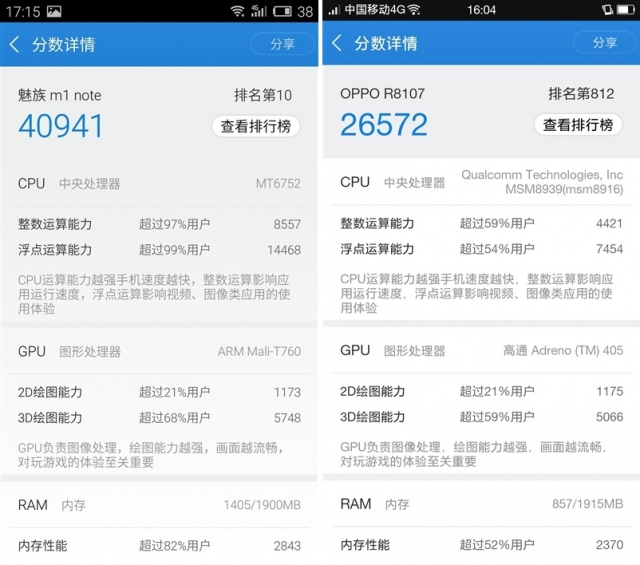
Ultimately, the OPPO R5's results are far behind what the iOcean M6752 has to offer. This means that the single-core performance of the M6752 is better than that of the OPPO R5, as the MT6752's results were almost double that of the Snapdragon.
Mediatek MT6752 vs. Snapdragon 615: Gaming Performance
Since both phones have a 1080p screen, their SoC must use the same amount of power. In this test, the SoC difference was determined using well-known games.

The iOcean M6752 smartphone is equipped with a Mali-T760 GPU. Output speed in main screen games Need for The speed is nominal, but the Mali GPU loses a bit in overall graphics fidelity.
In turn, the OPPO R5 has an Adreno 405 graphics card, which performed better overall. While smoothness and quality are excellent on both phones, the overall gaming experience on the Snapdragon 615 is as good as on the MT6752.
NBA 2015 is a fresh game at that time, requiring good performance from the processor and graphics card. The iOcean M6752 is quite free to play the game, slowing down just a couple of times, while the Snapdragon 615 really disappointed in this game. The processor had a lot of gameplay issues and the overall image looked sluggish.
Other tests:
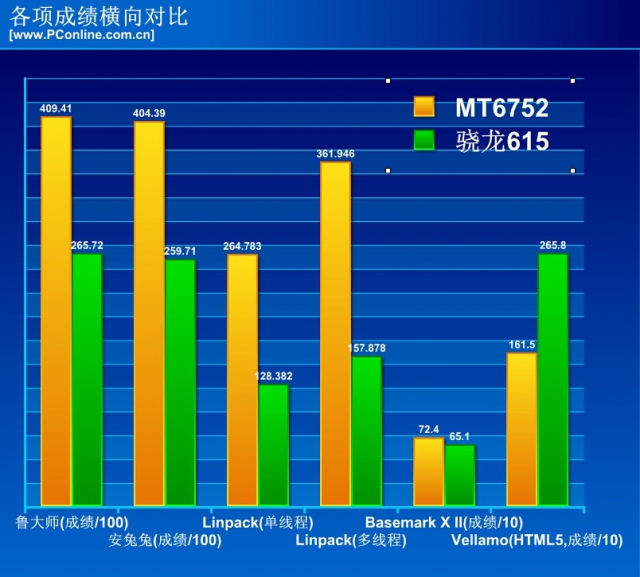
|
|
| Mediatek MT6752 and Snapdragon 615 |
|
|
| Snapdragon 615 |
|
|
| Mediatek MT6752 |
Mediatek MT6752 vs Snapdragon 615: Conclusion
While both processors offer high standards on paper and seem like they can handle anything, in fact the MT6752 in the iOcean MT6752 fared much better.
For most applications, each of the processors is good enough, but when it comes to anything complex, Mediatek's 64-bit processor can turn on the afterburner and handle heavy workloads intelligently and smoothly. It seems to me that Oppo made a big mistake by using the Snapdragon 615 instead of the Mediatek MT6752 in their device. Not only because the MTK chip is more powerful, but also because it helps bring down the price of the phone. This explains why iOcean sells their phone internationally for just over $ 200, while Oppo's price is approaching $ 500.
If you have dealt with any of these processors, please share your opinion in the comments.
Gone are the days when the vast majority of users had nothing to say about the name MediaTek. But even among those who heard about it, it was associated with continuous glitches of Chinese phones.
However, over time, this company from Taiwan became stronger and stronger and began to produce such processors for smartphones, which could compete with other market participants. This, of course, aroused interest among serious companies involved in the production of smartphones.
But Qualcomm from America did not sit still and somehow managed to squeeze such a monster as Texas Instruments from the market. As a result, they have taken a solid piece of the market for themselves. So, smartphones, with which processors should you give preference? Let's try to find the answer to this question.

The specialization of both companies is the development of processors. At the same time, none of them is engaged in the production of these products on their own. For this purpose, they attract such, for example, silicon giants as TSMC. This company owns just gigantic factories specializing in the production of semiconductor crystals.
Processors by these companies are being developed for gadgets of different price categories. They are based on such a processor architecture as ARM, which is fundamentally different from the computer x86. That is, perhaps, all the similarities between these developers. These direct competitors have a single field of activity. But they have different approaches to solving issues related to the development of their own products and their promotion.
Positive and negative sides of Qualcomm processors

The chips that are being developed for smartphones by an American company have many positive qualities:
- Delicate technological process... The American manufacturer is constantly striving to transfer the existing architecture to an updated technical process. And they do it at the slightest opportunity. For starters, processors made with the best technological standards are used in flagship smartphone models. And gradually more affordable products are being transferred to them.
- Using self-developed kernels... When creating the best SoCs for flagship models, the developers at Qualcomm are not limited to using the harvested ARM microarchitecture. They refine them in order to improve the performance of hardware resources and improve their optimization.
- Own graphics subsystem... In Qualcomm chipsets, the graphics processing process is GPUs from the Adreno series, developed by the company. She develops engineering ideas, and the finished products are launched into series. This is what contributes to an increase in the performance of leading GPUs. And it happens faster than competitors.
- Application of high power cellular modules... In chips Snapdragon parameters communication modems are better for the reason that all new technological trends are taken into account when developing them. For example, the introduction of support for LTE Cat. 12 started before she got provided cellular operators... In addition, Qualcomm modems support more, if compared with MTK, the number of network standards.
- Energy optimization... The company's specialists work not only on solving productivity issues, they pay a lot of attention to energy efficiency. Even in cases where it is associated with one technological process. For example, the implementation of the transition from Snapdragon 820 to 821 allowed not only to achieve acceleration of chips by a few percent, but also helped to reduce power consumption by the same few percent. And this is with minimal differences in the architecture of the models.
Now about the disadvantages of Qualcomm products:
High price threshold. An inevitable consequence of the constant use of advanced technologies is the expenditure of funds for implementation and testing. This is what drives the high cost of the best Qualcomm solutions. So, upon commissioning, the cost of the good processor Snapdragon 821 for 2016 smartphones was $ 70.
Complexity of the loader structure. It is customary to call a bootloader the mechanism by which the hardware starts, as well as the OS of smartphones. Its structure is somewhat complex for Snapdragon chips. The same can be said about the work algorithm. This does not affect the daily work, but if there is a need to restore the "brick" - the procedure becomes more complicated.
A small number of budget solutions. At the forefront of the company are chips for flagship smartphones, which are constantly being improved, made more powerful and more economical. But for budgetary decisions, there is no longer enough time. More recently, affordable Qualcomm smartphones have practiced the use of three processor models: Snapdragon 410, 400 and 200.
Positive and negative indicators of MediaTek processors
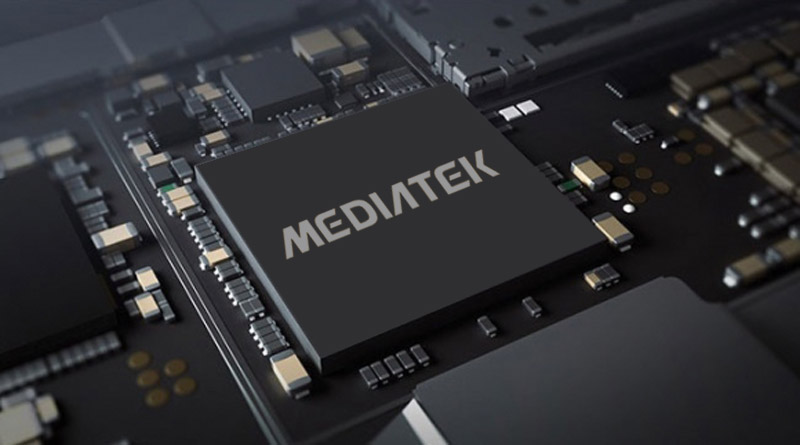
And Taiwanese chipsets have their advantages:
- Low cost... The initial focus of the company was precisely on cheap solutions, and in this niche it managed to firmly gain a foothold. But even the top models of MTK processors are not very expensive. So, the flagship Helio X20 can be purchased at the price of mid-range models from competitors.
- Big variety... MediaTek specialists are constantly concerned about improving the products manufactured by the company. For this reason, there is often an update lineup... It has a small number of flagship chipsets. But on the other hand, in the middle category, the abundance cannot but rejoice. The same can be said for the budget category. The company has a large number of SoC models.
- Stock graphics... In the bulk of MediaTek chips, the use of basic options is practiced graphics cores Mali from ARM Corporation. Due to the presence of a reference version of the microarchitecture, it is easier for developers to optimize games for it. The same cannot be said about Adreno. In addition, it is the Mali graphics that Samsung uses for its chips, which makes it a priority for developers in the adaptation process.
For the sake of fairness, it must be said that the processors of the MediaTek company have a lot of disadvantages:
- Using basic Cortex cores... The company does not have the resources that could be engaged in improving the microarchitecture of processors. This forces developers to use standard cores for chips. With the same frequency, they are inferior to the custom microarchitectures of Apple, Samsung and Qualcomm.
- Configuration imbalance... Puzzled by the improvement of autonomy, without worsening the commercial attractiveness of the products, MediaTek chose not the best path of development. Their processors are impressive at the development stage, but when it comes to practice, not everything works out as intended. Let's give an example. To optimize the charge consumption in the Helio X20 series processors, the engineers implemented three clusters of cores with different architecture, frequency and TDP. This was done instead of developing a more elegant energy supply mechanism. At the same time, the nuance was not taken into account that advertising of 10 cores is more effective than four, even if they are highly effective. Another disadvantage that affects the balance of hardware is not the most optimal selection of the configuration of the graphics subsystem. And although the MediaTek company uses the current models of the Mali GPU, the options chosen cannot be called the best. To make it clearer, let's take specific models... So, for the top-end Helio X25, as well as for the Exynos 8890, the Samsung S7 uses the Mali T880. But the Korean model uses the T880 MP12 configuration, and the MTK uses the T880 MP4 configuration. This means that the number of active blocks in the latter is three times less. This, of course, entails a 3 times lower performance.
- Backlog in terms of technological processes... Saving is a common business style for MediaTek. That is why they are in no hurry to make investments for the development of production at partner factories. Moreover, they do not have a reserve of resources for this. The consequence of this is that they are not given priority access to the best conveyor lines. This means that the production of MTK chipsets is carried out using rougher and outdated technological processes. This is especially true for processors for flagship models.
- Low level of developer support... Over the past few years, there has been an improvement in the situation, but the problems associated with the support of developers from MediaTek are not over yet. The consequence of this is sometimes untimely receipt by smartphone manufacturers of updated drivers, together with developer libraries. And this does not allow the production of smartphones with new version OS. In addition, OS updates from previous models are lagging behind. And if for a budget MT6580 there is Android kernel 6, it is absent for the flagship MT6795.
Conclusion

To say unequivocally where to stop your choice will not work with all the desire. Both MediaTek and Qualcomm have pros and cons. You can try to understand something if you break down into groups of processors. And then you get the following:
- Budget price category... It does not show any special differences between products from these manufacturers. Both developers create solutions that are sufficient to solve basic problems. That is, we can talk about parity here. The cost of MTK models is often lower, but this is most often explained by the fact that there are simply a lot of them. We can say that the priority in this price niche belongs to MediaTek.
- Consideration of the average price point allows us to talk about leveling the advantage of a Taiwanese company... Qualcomm models located closer to the upper limit of this price segment features a more powerful level of graphics and a better solution to the issue of optimizing energy consumption. However, such an indicator as performance is the same for both. And we can say that at this point the companies have a draw.
- Processors used in flagship models - Qualcomm's prerogative... According to this indicator, the company is the leader among Android smartphones. And today's reality is such that MediaTek cannot oppose anything worthy in this segment.
And it turns out that the consumer must make his own choice in accordance with his preferences and requests.








